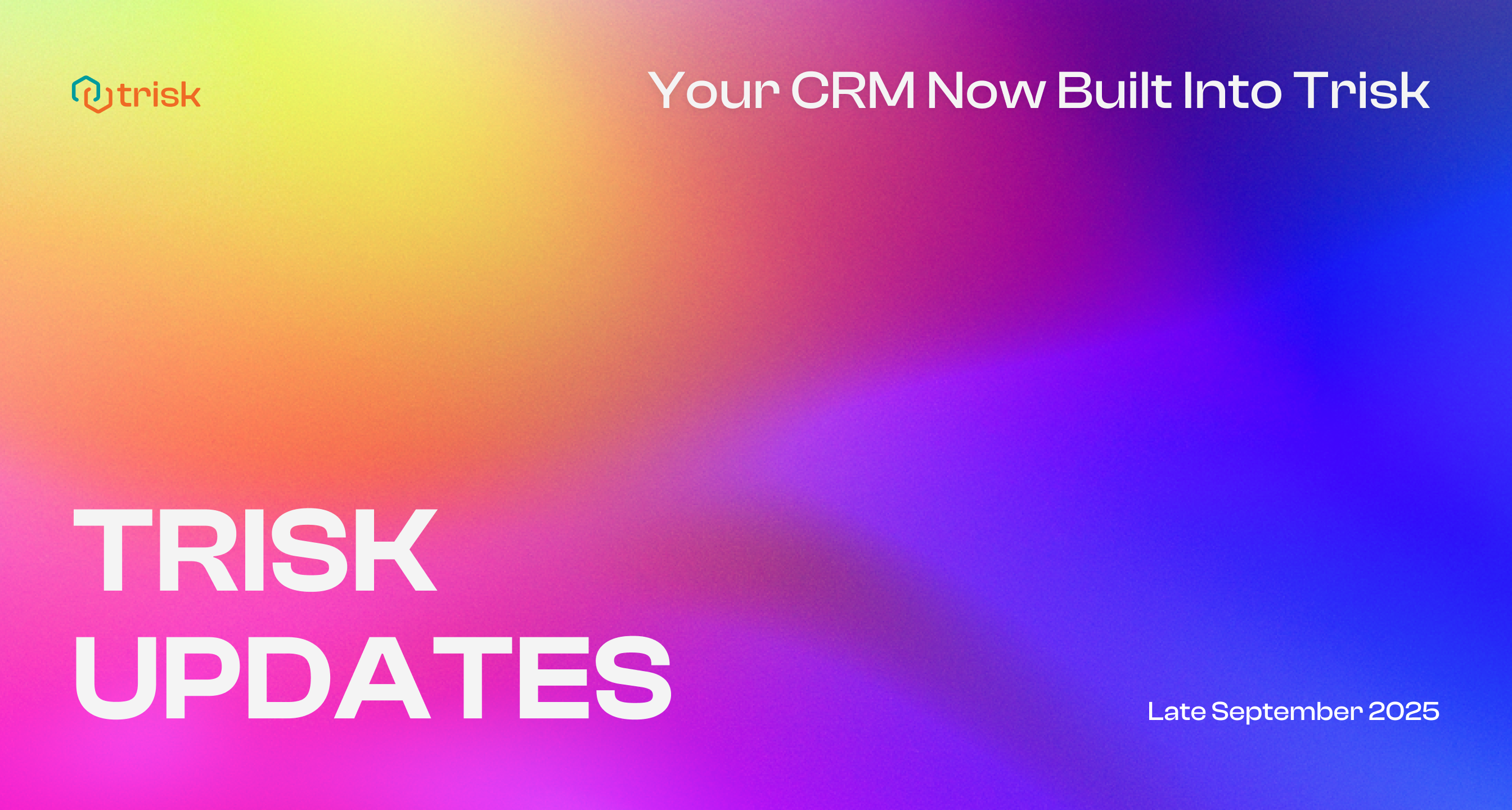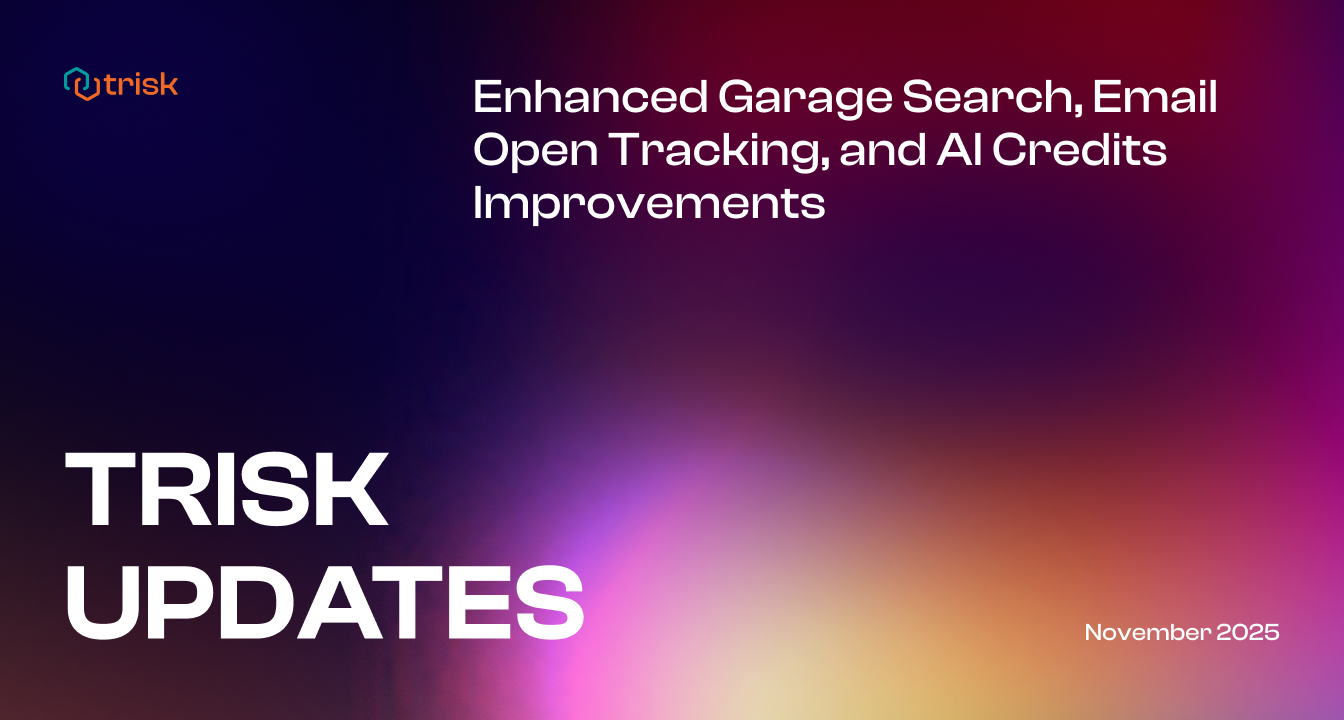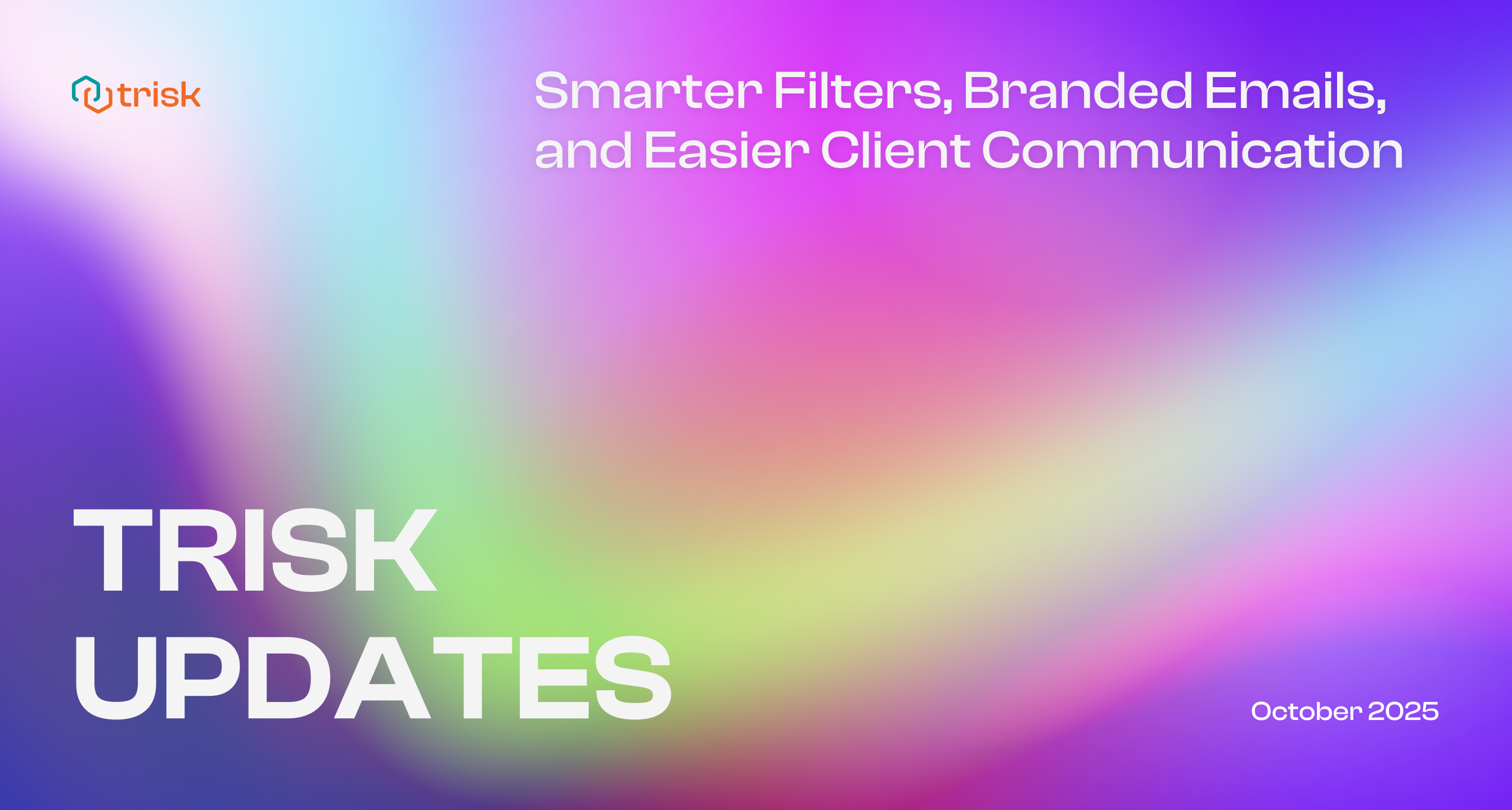This release brings actual CRM-style power to Trisk.
You can now tag and filter clients by status or category, automate tagging based on form responses, and even launch recurring workflows with IF/THEN Logic.
And for all the moments where quick reminders matter, you can now write Notes directly on client profiles—organized, permission-controlled, and always in context.
From classification to automation, context capture to clean-up—Trisk now helps you manage the full client lifecycle without jumping between tools.
Tag and Filter Clients with CRM-Level Clarity
With this update, we bring CRM-style functionality directly into the Clients module. You can now tag and filter client profiles by tags—giving your team a simple way to mark stages, highlight priorities, and keep every account organized.
Tags are completely flexible: create categories that match how your firm works, whether that’s “Prospect”, “Lead”, “Closed Deal”, “VIP”, or anything else your process requires.
What’s New
Tags on Client Cards and Profiles
- Add, edit, or remove tags to define client categories.
- Tags appear directly in the client list and at the top of profiles for instant visibility.
Filter by Tag
- A new Tag filter has been added to the Filters in the “All Clients” and “My Clients” Menus.
- Narrow the list instantly by selecting one or multiple tags.
- A new “Show Client Only” checkbox in Filters instantly shows only the accounts where you’re assigned as Account Executive.
Search with Tags
- Quickly find clients across the client lists or via Global Search using any tag.
Permission Control
- A new “Add / Remove tags” permission governs who can add or edit tags, ensuring categories stay consistent across the team. (Main Menu > Governance > Roles & Permissions > Studio Permissions )
Trish Hints
- Trish hints will appear the first time, guiding you to the new tagging option.
How It Works
- In the Clients list, click + Add Tag on any client card.

- Apply an existing tag or create a new one.
- Use the Filters to narrow clients by tags. (optional)
Real-World Use Cases
Accounting Firm | Pipeline Reviews
Managers tag clients as Prospect, Lead, or Active Engagement and instantly filter by stage to prepare monthly reviews without manual sorting.
Legal Practice | Matter Tracking
Teams use tags like In Negotiation or Closed Deal to standardize client status across partners and provide leadership with a single, trusted pipeline view.
Why It Matters
CRM inside Trisk – A lightweight way to track clients without leaving the platform.
Custom-fit categories – Use tags to match your exact process, from sales pipeline stages (Prospect, Lead, Closed Deal) to priority markers (VIP) and more.
Standardization & team-wide consistency – Everyone follows the same tagging system. All managers categorize clients the same way. Result – less chaos, faster handoffs, and a cleaner client pipeline.
Focus & Efficiency – Analyze clients by stage or group to track deal flow, spot bottlenecks, and evaluate sales performance without extra spreadsheets or exports.
CRM power without CRM complexity – Replace fragmented spreadsheets or basic CRMs with a focused, built-in system that’s designed for professional services.
Important Notes
📌 Tagging is available starting from the Teams Plan.
📌 Tags added in Teams remain visible across all plans, but can only be modified in Teams.
Automatically Tag Client Profiles Based on Form Answers
One more manual task you can now delete from your to-do list.
Client tagging can now be automated—triggered directly from form responses using IF/THEN Logic.
No post-submission tagging.
No forgotten follow-ups.
This is CRM-level automation—now native to Trisk.
What’s New
You can now automatically add or remove tags to a client profile based on how they answer a form.

Here’s what you can do:
- Add a tag (e.g., “Tax” or “VIP”) the moment a client selects “Yes” to a qualifying question
- Remove a tag (e.g., “Prospect”) when the status advances
- Keep client profiles automatically up-to-date without manual work
- Trigger logic that builds clean, categorized pipelines.
Tags applied or removed this way are:
- Instantly visible in the client profile
- Logged in the task’s Activity History
![]()
- Reversible based on new inputs
- Respect the same tagging logic you already use across the platform
Important Notes
📌 This automation is available starting from the Teams Plan.
📌 IF/THEN Tags do not apply to Surveys.
How It Works
In the Form Builder, inside your IF/THEN Connect block, you’ll see two new Action types:
– Add Tag to Client Profile
– Remove Tag from Client Profile

You’ll be able to:
– Select one or more existing tags
– Or create a new tag on the fly (based on your permission)
Once the form is submitted:
- If the condition is met → tag is added
- If the condition no longer applies → tag is removed
Real-Time Error Prevention
Tags added/removed via form automation will not duplicate. If someone attempts to change their answer, the system will undo the tag without affecting any other changes.
Let’s say you have a rule:
If “Investment size > $100,000” → Add tag 100K+
Now, someone accidentally selects “Yes,” and the tag is added.
However, they catch the error and change their answer to ‘No‘.
With this update, Trisk automatically removes the 100K+ tag to prevent any misleading classification.
No need to manually clean it up.
This removal logic ensures:
- Your tags reflect real-time data
- Mistakes are corrected instantly
- Manual cleanup is eliminated
Like this new tool? Check also our IF/THEN Workflow Launch.
With IF/THEN Workflow Launch, your forms can automatically trigger workflows based on user responses, eliminating the need for manual setup and enabling processes to run without waiting for someone to click “next.”
Why It Matters
Tags are extremely powerful when they’re kept up to date. Create the logic once, and the platform applies or removes tags exactly when needed.
This means:
- Smarter, dynamic filtering
- Cleaner pipelines and status management
- Less manual work across your client journey
- More accurate segmentation for workflows, Surveys, or reports
Real-World Use Cases
| Industry | Old Way | With IF/THEN Tagging |
|
Tax & Compliance Firms |
Staff sorted clients by entity type (Individual, LLC, Corporation) after onboarding. |
Entity tags are automatically applied based on the client’s answers in the form. |
| Sales Teams |
Removed Lead tags only when reminded |
Tag removed automatically when |
| Real Estate Agencies |
Applied Buyer, Seller, Investor tags by hand |
Profile is tagged dynamically based on the form answers |
|
Deal Pipeline Managers |
Had to manually clean up status tags |
Prospect removed and Lead added based on form logic |
Recurring Workflow Launches Now Work with IF/THEN Logic
Recurring workflows in Trisk have just received a serious upgrade.
With this update, you can tie recurring launches directly to IF/THEN Logic in the Form Builder. That means you can schedule workflows conditionally— when the right form input triggers the right logic.
It’s no longer just “launch every 30 days”—it’s extra precise control with “launch every 30 days if this box is checked.”
Did you know that you can schedule Recurring Launches for multiple clients or internal teams—all at once, with a single setup. Check out our July update about Bulk Recurring Launch.
What’s New
Recurring Launches Triggered by IF/THEN Logic
Use IF/THEN Logic inside your Form Builder to schedule recurring workflows only in cases when specific form inputs are selected.
Granular and Context-Aware Scheduling
Tie schedule automation to client answers, dropdowns, checkboxes, select fields—anything you can map with Trisk’s IF/THEN Connect. Precise control, no one-size-fits-all automation.
Flexible Scheduling
Everything you loved about recurring setups (frequency, start/end dates, repeat logic)—now dynamically applied.
Visual Clarity in the Builder
You can see exactly where recurring launches are tied to IF/THEN Rules, helping your team stay in control.
 How It Works
How It Works
- Choose the IF/THEN Connect tool in your Form Builder
- Add an IF/THEN Rule with “Launch Workflow” as the action
- Enable the Recurring Launching checkbox

- Customize your schedule

- Trisk handles the rest:
- First workflow launches instantly (if set)
- Future workflows auto-schedule based on logic and recurrence
You now have logic-based automation that repeats itself—without any manual setup needed later. Trisk reads the logic and runs on autopilot.
Real-World Examples
| Use Case | Before | Now |
| Accounting & Tax Firms |
Every month, staff manually launched workflows to request bookkeeping records from clients. |
A recurring workflow launches automatically every month—but only for clients who selected “Monthly Bookkeeping” in the intake form. |
| Real Estate / Property Management |
Managers manually launched inspection workflows for every property every quarter. |
Inspection workflows auto-launch quarterly—only if the property was tagged as “Rental” in the client’s intake. |
| HR – Onboarding & Review Cycles |
Created the same schedule for every hire |
IF/THEN rules create recurring check-ins only for full-time staff |
Why It Matters
Logic + Recurrence = Smart Automation
Workflows repeat based on real-world logic.
Less Noise, More Focus
Don’t overwhelm your team with unnecessary repeat tasks. Trisk launches what’s needed, and when it’s needed.
Perfect for CRM-Like Operations
From follow-ups to renewals, automate your recurring logic like an innovative CRM—but purpose-built for professional workflows.
Safe by Design
If the logic isn’t triggered, nothing is launched. No duplicates. No accidents. No clutter.
Add Private Notes to Client Profiles: Keep Key Context Without Leaving Trisk
In professional services, the small details matter. A quick reminder after a call, a preference for email over phone, or a note about an upcoming deadline—these details often decide the quality of a client relationship.
Now, Trisk gives you the ability to add private notes directly to client profiles. It’s a CRM feature that helps you capture context without switching tools, breaking workflows, or cluttering tasks.
What’s New
Notes on Client Profiles
- A new “Notes” section is now available on every client profile.
- Add quick text notes that stay linked to the profile—even if it’s archived.
Internal Visibility
Notes remain visible within your organization to ensure alignment across the team. They are strictly hidden from client users.
Permissions Control
A new permission, “Add notes”, governs who can add notes. Users without this permission can still view notes, but cannot add new ones.
Notes are never visible to client users.
Consistent Experience
Notes reuse the same interface you already know from Forms.
Trish Hint
A short Trish hint highlights the new Notes field the first time you open a client profile.
How It Works
- Open a Client Profile.

- In the Notes section, click on the Add Private Note field.
- Write and save your note—it appears with your name, avatar, and timestamp.

- Edit or delete a note at any time.
Real-World Use Cases
Accounting Firm | Meeting Follow-Up
An accountant adds a note: “Requested Q3 reports by Friday.” The reminder is always visible in the client profile, no need to track it elsewhere.
Consulting Team | Contact Preferences
A consultant adds: “CEO prefers email, avoids calls during mornings.” This private note keeps communication smooth, eliminating the need for reminders.
Legal Practice | Long-Term Context
A partner records: “Contract negotiation style: prefers written summaries before calls.” Even after the client is archived, the note remains accessible if they return later.
Why It Matters
Capture context instantly – Record key details right after a call or meeting, so nothing gets lost.
Boost personal productivity – Keep private reminders without spamming tasks, emails, or teammates.
Protect sensitive information – Notes are private to the author and permission-based.
Consistent client history – Notes remain available even when profiles are archived, ensuring context is never lost.
CRM essentials inside Trisk – Provides one of the most used CRM features, built directly into client profiles.
With these updates, Trisk gives you the core functionality of a CRM—natively built into your workspace.
- Tags help structure pipelines and categorize clients across your firm, with flexible filters and standardized workflows.
- IF/THEN automation enables you to apply or remove tags based on real-time logic, eliminating the need for manual upkeep and errors.
- Recurring workflows can now follow IF/THEN Logic, launching only when relevant, reducing noise and boosting efficiency.
- Notes capture key context—client preferences, follow-ups, and insights—linked to profiles and never lost.
Together, these features replace the need for disconnected CRMs, spreadsheets, and reminder systems. Trisk becomes your single source of truth for the client organization, automation, and context.
The result: fewer tools, less chaos, and more time spent delivering value.
Want to go deeper into what else Trisk can do? Check out:
- Tailored Onboarding That Adapts to Your Firm – See how Trish now personalizes onboarding flows and helps clients start faster.
- AI That Thinks Like Your Team – Discover how Organizational Knowledge gives you AI that follows your firm’s rules.
- Email Triage with Trish AI – Reclaim 200+ Hours/Year per Employee.


